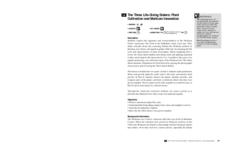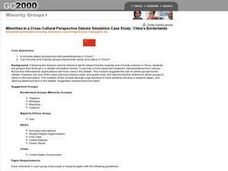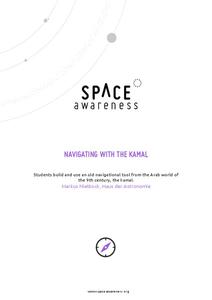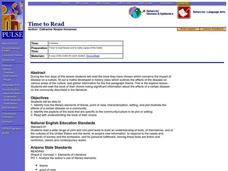Curated OER
Lesson: Double Album: Sentence as Thought
The cut-up technique invented by surrealist artist Tristan Tzara is the focus for today. Young artists examine the technique and analyze its use in relation to expressing and viewing the world. They then use a newspaper to create a...
Channel Islands Film
Dark Water: Lesson Plan 1 - Grades 3-4
As part of their study of the history of the Channel Islands, class members craft an informational article to post on a bulletin board that features the Chumash ancestral tradition of tomol paddling.
Curated OER
Aboriginal Physical Education
Students engage in p.e. activities that have roots in native Indian, Metis, and Inuit cultures. They practice the skill involved and listen to the significance behind the skill. They read relevant books and define new terminology.
Berkshire Museum
The Three Life-Giving Sisters: Plant Cultivation and Mohican Innovation
Children gain first-hand experience with Native American agriculture while investigating the life cycle of plants with this engaging experiment. Focusing on what the natives called the Three Sisters - corn, beans, and squash - young...
Carolina K-12
What Is the American Dream?
How do you describe the American Dream? What motivates others to immigrate to the United States, and why do some groups have trouble attaining the American Dream? Your learners will consider these questions as they explore figurative...
Curated OER
Say Hi to Haibun Fun
What is a haibun? With this interesting lesson, writers will experience the Japanese writing form haibun, identify elements important to Japanese writing styles, analyze a haibun, and compose their own. Different from the typical journal...
Curated OER
Truth Or Consequences
Students examine historical works of art and analyze how these paintings could be used for personal, cultural, and/or political purposes. This exploratory lesson on art ideology includes two handouts/worksheets for student use and...
Curated OER
Holi-Days
Students research an event, celebration, or observance from a culture with which they are not familiar and present their information to the class in this cross-curricular look at festivals and celebrations. The lesson includes an option...
Curated OER
Observational Drawing
Students create drawings using oil pastels that convey cultural, social and historical meaning. Drawings are evaluated on use of color planning, contour drawing, color blending, line and pattern.
Curated OER
Studying Mind Maps Created at Other Schools
Students explore Africa and mind maps created by students from other schools. They discuss Africa and the number of countries, diversity of language, cultures, races, religions, and lifestyles and in groups study a mind map from another...
Curated OER
The Baltic Sea
Students study the Baltic Sea and the bordering countries. In this environmental lesson students study changes in environment and develop a sustainable future.
Curated OER
Painters as Musicians-CD Cover Design
Students create CD cover art to project the image of the artist or what those artists might sing about.
Curated OER
Minorities in a Cross-Cultural Perspective Debate Simulation Case Study: China's Borderlands
Twelfth graders investigate if minority status is synonymous with powerlessness in China. They examine if minority and majority groups interact with equity and justice in China. Students present their findings in a debate-simulation format.
Curated OER
Case Studies: Cross-Cultural Comparison
Students examine maps of Lebanon, Vietnam and Nigeria, discuss relationship between ethnicity, land and conflict, review material from case studies, complete comparison chart, and write essays comparing two of the case studies.
Curated OER
WOMEN'S AND MEN'S ROLES IN DIFFERENT CULTURES
Students examine careers that are not traditional to their gender.
Curated OER
Border Identity: AngloChicaNorteña
Learners analyze concept of identity in the context of the border region, and in particular by considering the concept of identity in a movie concerning a famous border personality.
Curated OER
How My Parents Learned to Eat
Students identify popular foods in Japan. In this social studies lesson, students read the story How My Parents Learned to Eat and discuss ways that the Japanese eat their food. Students research popular foods in Japan.
Curated OER
African Masks And Their Impact On Western Art
Explore the influence of African-style masks on Western art. Learners create individual masks using construction paper. They discuss and explore the techniques used to create these types of masks. The resource includes links to...
PBS
Stories of Painkiller Addiction: Contemplating Nature vs. Nurture
Does having an addict in your family make it more likely to become one yourself? Explore the genetic risk factors, as well as the prominent environmental influences, for substance addiction in a instructional activity that encourages...
Curated OER
My Story and History: Peeking into the Past with Paintings
Consider how you can use a visual source, such as a painting, to learn about a historical time or event. Young learners discuss primary sources and how they differ from secondary sources, then analyze the painting Mother and Child by...
US Mint
Absolutely and Relatively: The Puerto Rico Quarter Reverse
How much does your class know about Puerto RIco? How much can they learn from the back of a 2009 quarter? Use the coin, part of a series of quarters that depict US territories, to teach learners about the geography, culture, and history...
Curated OER
Origami Ducks: Geometry, Listening, and Following Directions
Make origami ducks with your class to reinforce geometry concepts and vocabulary; develop fine motor and visual translation skills; and enrich study of Japanese culture, the pond habitat, or migration. Create a whole group "worksheet"...
Space Awareness
Navigating with the Kamal
Historians have proven that as early as 1497 skilled navigators were using a kamal to sail across oceans. Scholars learn about navigation tools and astronomy before building their own kamals. They then learn how to use it to determine...
Curated OER
Time to Read
Students identify how the literary elements of theme, point of view, characterization, setting, and plot illustrate the effects of a certain disease on a community. They identify the aspects of the book that are specific to the...
Other popular searches
- Cross Cultural Dialogue
- Cross Cultural Understanding
- Cross Cultural Dialogue
- Cross Cultural Dialog
- Cross Cultural Semantics
- Cross Cultural Experiences
- Cross Cultural Understanding
- Cross Cultural Dialog
- Cross Cultural Effectiveness
- Cross Cultural Literacy
- Cross Cultural Lesson Plans
- Cross Cultural Connections























